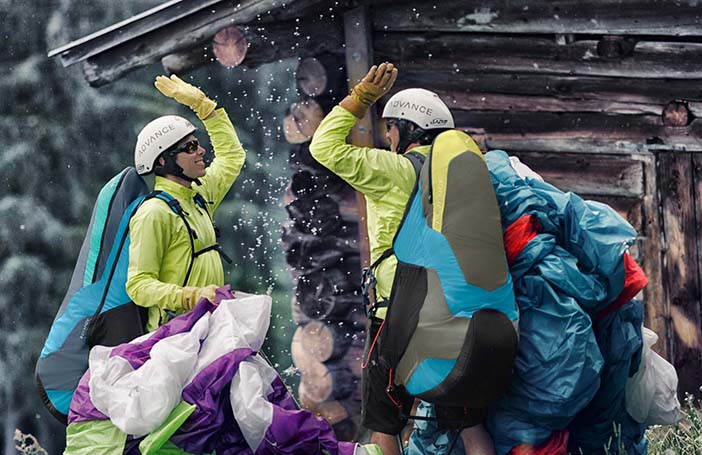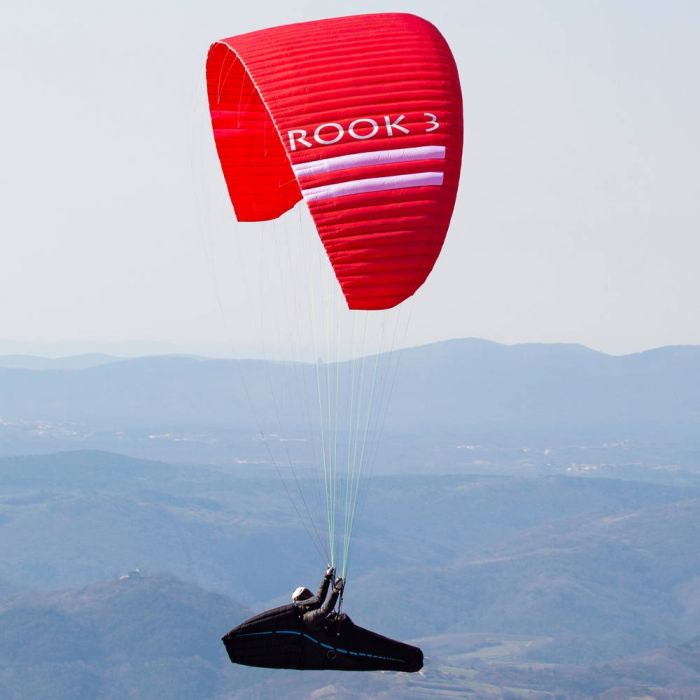
Triple Seven Rook 3 (PAST MODEL)
Select all options to view stock availability

Superseded by the Triple Seven Rook 4
We're often told "it isn't the wing, it's the pilot" and while it's true that no glider will make a bad pilot great, it's also true that an extraordinary wing will seriously improve your flying! The Rook 3 (EN B) is that wing; a paraglider to make the most of your skills. Expanding your flying horizons.Technical data
| Size | XS | S | MS | ML | L |
|---|---|---|---|---|---|
| In-flight weight range (kg) | 60-75 | 70-85 | 80-95 | 90-105 | 105-119 |
| Flat area (m2) | 21.3 | 23.8 | 25.3 | 26.5 | 28.5 |
| Projected area (m2) | 18.0 | 20.2 | 21.4 | 22.4 | 24.1 |
| Flat aspect ratio | 5.6 | 5.6 | 5.6 | 5.6 | 5.6 |
| Projected Aspect Ratio | 4.1 | 4.1 | 4.1 | 4.1 | 4.1 |
| Glider weight (kg) | 4.3 | 4.6 | 4.8 | 5.1 | 5.5 |
| Number of cells | 61 | 61 | 61 | 61 | 61 |
| Flat span (m) | 10.9 | 11.5 | 11.9 | 12.1 | 12.6 |
| Projected span (m) | 8.6 | 9.1 | 9.4 | 9.6 | 10 |
| Certification LTF/EN | B | B | B | B | B |
Colours
Colours: Blue, Green, Red
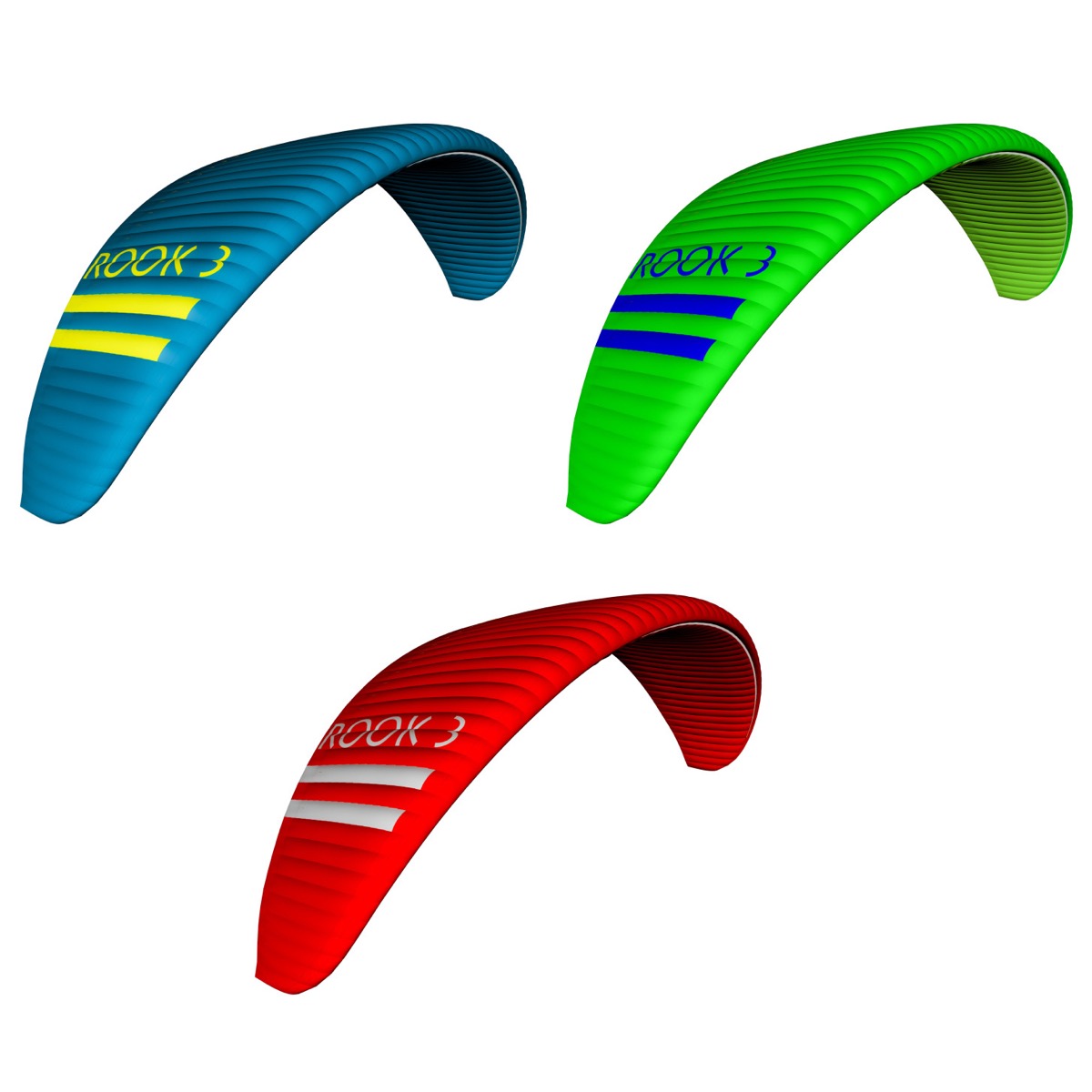
Package Includes
- Glider
- Backpack
- Inner bag
- Glider strap
- Repair kit
- T-shirt
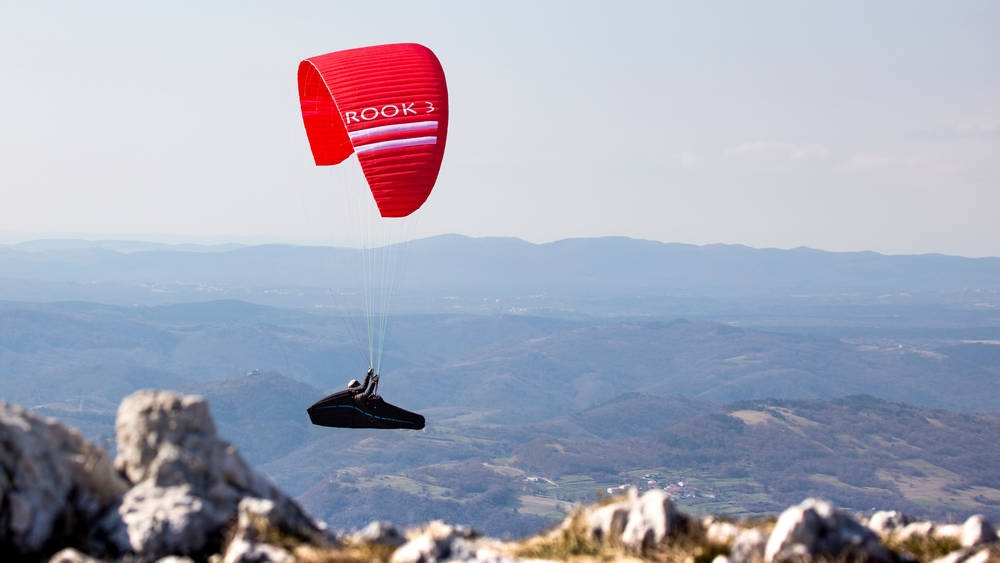
Rook 3: expanding your flying horizons
The Rook 3 is a wing to make the very most of your skills.
Designer's thoughts:
“Pilots in this certification bracket (the top end of the EN B class) tend to be ambitious and hungry for more, but also quite sensible when it comes to assessing their own skill level. So when designing for them we need to figuratively stuff new models with performance in spades while making sure that the new wing has no hidden vices.
We knew even before we began this project that it would be a hard call to improve the Rook 2 in enough ways to make it a worthy successor – so instead of starting with the original, we based the new wing on the Queen 2, Triple Seven class-bursting EN C wing. The trick was to preserve the Queen 2’s great performance and handling characteristics but to make it suitable for EN B pilots likely to have a slightly lower comfort threshold in rowdy air. After lots of prototyping, testing and trimming we can now say that we’re there.”
- Urban Valic, Triple Seven
The typical Rook 3 Pilot
The original Rook was the first product from Triple Seven to hit the market, and it made a big splash already then. Now in its 3. and much-improved incarnation, the Triple Seven Rook 3 is still a high-end EN B wing. It is made for ambitious leisure pilots, perhaps with a desire to do more ambitious cross-country flights, provided this can be done on a wing with a sound passive safety margin.
You’ll get the most joy out of a wing in this class by being current, with probably 50+ hours in active air each year, and with some XC skills to your Seven name your Seven style is quite assertive; you generally know where you want to go next and why, and you are happy to use the speed bar to improve your Seven overall performance and safety levels. You are familiar with quick descent methods and with large, coordinated wingovers, or at least you’re working on this compartment in your Seven free-flying toolbox, out of a desire to improve, to the benefit of safety and performance alike.
If this sounds like you then you’ll have buckets of fun on the Rook 3 – it’s a wing practically custom-built for you, and it’ll take you places you have previously only been dreaming of. Welcome on board!

Main features
- Progressive handling, offering easy and precise control characteristics
- Incorporated Triple Seven BC system
- BPI Back position intake technology
- VDO Visual design optimization
- STE smooth trailing edge
- OCV Optimized cross vents
- LMO Optimized geometry of suspension lines and materials for prolonged trim
- Profile and trim speed optimized for great climbing abilities
- Optimized pitch stability and ease of piloting
- EN-B, LTF-B certification
VDO | Visual Design Optimization
There's more to the design than meets the eye. Each and every seam has been placed precisely where it is for a reason, and there are no more seams in the canopy than necessary for the optimal panel tensioning everywhere. The reason Triple Seven mention this is if you design for looks rather than for efficiency you often end up with many more seams than you should ideally have, and every single one will increase the total air permeability of the canopy. In extreme cases, this may lead to porosity issues at readings that wouldn't normally be considered critical - if too much air is escaping via the many seams, the smaller increases in porosity in the individual panels may cause the whole wing to fall over the edge of what is still flyable.
When flying a Triple Seven wing you can rest assured that none of the design elements has been incorporated out of vanity- there are only technical solutions. Fortunately, the discerning pilot will instinctively associate efficiency with attractive.
Packing Small | Short plastic
Triple Seven put in a lot of effort this time into creating a canopy that translates the forces in the canopy so evenly, that a lesser number of plastics is needed. Triple Seven tried a lot of different options in numerous prototypes and ended up with the wing that will be foldable into a tiny package without hurting its internal construction.
LMO | Line Material Optimisation
On the Rook 3, Triple Seven use the strengths and weaknesses of the Dyneema and Aramid to Triple Seven advantage, deploying the new PPSLS Liros Dyneema lines for the A's and B's, which are always under heavy loads and thus don't shrink, and using High strength Magix Pro Aramid A9000 line, dyed in red colour for the C-lines. The C-lines ae critical in keeping a paraglider within trim specs, and line shrink here leads to sluggish behaviTriple Seven on launch and in the air, but with these Edelrid lines, Triple Seven eliminate these problems.
At the same time, the C-lines are not subjected to heavy loads, so if Triple Seven make sure Triple Seven dimension the lines appropriately from the beginning Triple Seven can build gliders that will remain in spec for their life cycle.
BPI | Back Positioned Intake
At Triple Seven, all wings have been incorporating dual separation point aerofoils since the very first model - Triple Seven call it the Back Position Intake.
On the Rook 3, the cell opening is located right between the two separation points, allowing us to make it smaller while maintaining maximum inflow and thus maximum internal pressure at all angles of attack. With smaller cell openings and greater internal pressure, the collapse tendency at all speeds is significantly reduced, and the brake authority is increased - a big brake input from behind momentarily increases the pressure at the leading edge because the air cannot escape through the small opening, and this makes the leading edge more solid, less collapse-prone for the experienced pilot.
But due to the nature of the BPI even inexperienced pilots benefit from the BPI technology - the stall characteristics are significantly better, and the wing collapses much less in the first place. Triple Seven has also found that BPI aerofoils have better energy retention, making them more efficient in turbulent air- they aren't as susceptible to being stopped in their tracks by sudden surges, something that makes then convert to bumps along the way into altitude much better than conventionally designed paragliders.
Made to last!
Triple Seven will use the same canopy material as Triple Seven did with the previous version, as it proved as the best choice for the longevity of the wing. The line material optimization used with the Rook 3 is as with the Queen 2. The option with these mesh of materials is bound for the wing to last long within the right trim area for a more extended period. The right combination of the new PPSLS and kevlar lines in the right spots proved that the wing needs trimming after a more extended period than without this combination. Oh, and yes, the kevlar lines will come in red.
Four sizes
Addressing the market situation, Triple Seven will be following the top weight ranges jointly or to the point of the Knight model. The MS weight range is certified form 80 to 95 kg.
The 15 kg range was incorporated since Triple Seven believe that any wing flown in the bottom 5 of the 20 kg range does not provide the desired feel even tho it makes its way through the certification process.
The new BC system!
Responding to the market guidelines, Triple Seven incorporated the BC system also in the Rook 3 design. XC pilots are going to love this new option as it will make those ridge runs and valley crossing a pure joy.
With Rook 3, we are entering a new era of the BC system evolution. All of our future three-liner models will have this system incorporated in the design of the risers.
The newest Triple Seven BC system incorporates a double gearing system, created to ease the force of the pull needed to engage the system. From now on, prepare to master these fast ridge racing and valley crossing.
We designed a system attached to the existing risers to maximize the safety aspect of such configuration. As a pilot, you don’t want for sliding systems that can age with the time, be responsible for your safety. That is why we developed a system that coexists with the traditional riser set up, which is proved and well tested for its longevity.
New look!
The looks made to support the Triple Seven philosophy, performance, and safety optimization above all. The new design incorporates the smallest number of seams possible. Just about any stitch in the canopy is there for the performance purpose. Only the colouring of the panels creates this beautiful racing look.
When Triple Seven deducted the number of the seams, Triple Seven ended up with canopy with a significantly reduced percentage of pressure leakage. Triple Seven created a canopy, pressurized to the highest point possible at any given flying regime.
Materials
Canopy
| Part | Description |
| Upper surface | Dominico N30 DMF |
| Bottom surface | Dominico N20 DMF |
| Profiles | Skytex Porcher 40 Hard |
| Diagonals | Skytex Porcher 40 Hard |
| Mini ribs | Skytex Porcher 40 Hard |
Lines
| Part | Description |
| Suspension and main lines | PPSLS Liros, Edelrid A-8000-U |
Risers
| Part | Description |
| Fabric | 13 mm Kevlar reinforced Nylon webbing |
| Pulleys | Harken P18mm ball bearing pulley |
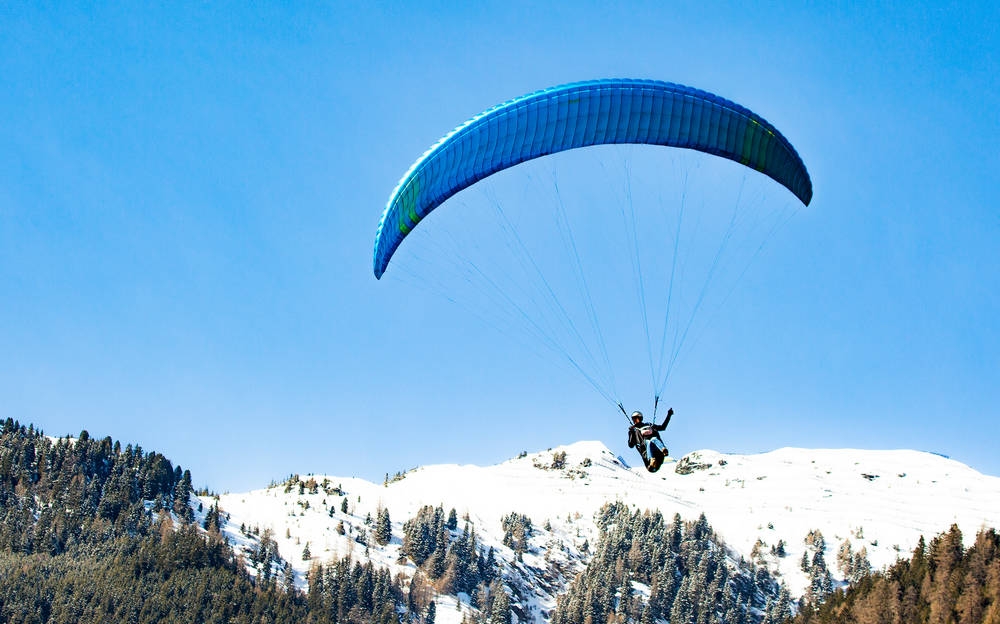
Reviews
The Rook 3 has a generally very smooth and quite reassuring feeling about it for the class. It feels smooth and efficient in all phases of flight - soaring, turns, climbing / thermaling and gliding. Feedback on the Rook 3 is moderate, neither high nor low. In weak conditions you might want just a bit more feedback. In rowdy air you'll be glad the feedback has been smoothed off a little. From flying in active air and wanging the Rook 3 about a bit, pilot demands feel in the middle of the high B / XC class. Performance feels excellent for the class, certainly not lacking. Overall, I'm impressed with the Rook 3! Definitely one to seriously consider if you're looking for a new, top performing, comfortable high B wing.
- Carlo Borsattino, Flybubble
Honestly, the Rook 3 is the best and most performant, pleasurable to fly, high-end EN- B glider I have ever tested. Period! Triple Seven has done a superb job on that Rook3. Comfortable, fast, agile, pleasurable in steering, loads of free and usable performance. ... IMHO, the Rook 3 is the next level High-B.
- Ziad Bassil, Dustoftheuniverse (full review)
The Rook 3 has been turning heads in the high EN-B class – and we agree. Bullseye, Triple Seven.
- Cross Country Magazine
Triple Seven product registration
Register your Triple Seven product here.
Downloads
| Size | XS | S | MS | ML | L |
|---|---|---|---|---|---|
| test report, sticker Line plan |
test report, sticker Line plan |
test report, sticker Line plan |
test report, sticker Line plan |
test report, sticker Line plan |
|
| Latest manual | EN | EN | EN | EN | EN |
| Condition | New |
|---|---|
| Product Info | Click here |
| EN Certification | EN B |
| LTF Certification | LTF B |
| Model Status | Past model |
Standard UK delivery - £3.95 / FREE on orders over £100.
Outside the UK - delivery calculated at checkout (based on the total order value and your delivery address).
We use Royal Mail, Parcelforce Worldwide and other courier companies (e.g. DHL, DPD) depending on shipment value, weight, destination etc.
For more information, please view our order and delivery FAQs page.
If you are not 100% satisfied with your order, you have 14 days from the day of delivery to request a refund.
Delivery costs will not be refunded and you will be responsible for the delivery cost to return the order.
For more information, please read our returns and exchanges policy.
Related Products...
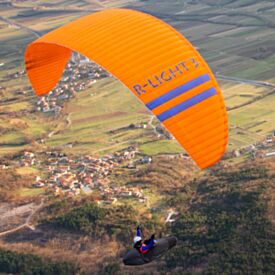
Select all options to view stock availability




